Source - http://www.southeastasianarchaeology.com/2013/10/16/rock-art-from-merapoh-pahang/#more-8812
In the last year, a group of cavers1 have been exploring the limestone caves near Merapoh, in Pahang, Malaysia. In their survey of about a 100 caves, they have discovered a number with drawings in them and they have asked me to comment on them.
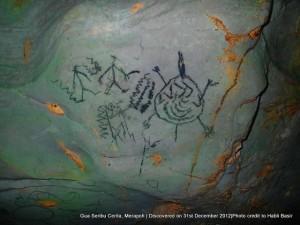
Rock art at Gua Seribu Cerita near Merapoh, Pahang. Photo: Habli Basir.
Six caves with drawings have been identified (Technical note: drawings=applied dry, paintings=applied using wet pigment). They are black in colour, which suggests charcoal, and if so might potentially be carbon dated. That said, black rock art in Southeast Asia tends to be more recent2, and some of the subjects depicted on the rock also suggest a recent time frame (perhaps in the last 200 years). The relative freshness of the rock art also suggests a young age. Of course, I haven’t been to the sites myself and I’m commenting off photographs so I could be wrong.
Black drawings are fairly common in Peninsular Malaysia, and they have been associated with the orang asli (literally, the original peoples) of Malaysia. Evans3, an early ethnographer observed orang asli in Perak creating similar drawings and they were described as drawing items that they saw in their daily lives. Black coloured rock art sites are fairly common in peninsular Malaysia and as far north as Southern Thailand, so the discovery of more sites is not surprising. In Pahang, two previously noted sites are Gua Kechil4 and Gua Luas5.
The first of these sites is named Gua Seribu Cerita (Cave of a Thousand Stories, quite poetic!), and is said to contain hundreds of drawings located over a number of panels throughout the cave. This site has quite a number of interesting pictoral elements.
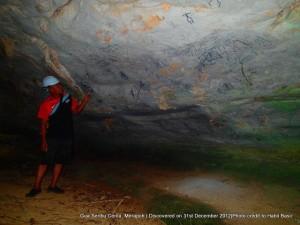
Gua Seribu Cerita. Photo: Habli Basir.
When taken in concert, some of the drawings suggest a fairly recent (maybe the last 100-200 years) creation date. Depictions of an ‘agricultural’ scene where a people are are standing in the middle of fields, which have been demarcated by a square look like farming of some sort. A series of lines at the bottom of another panel look like ‘train tracks’ – interestingly enough, the railway passes within a kilometre of the cave. Although there is no train depicted, there appears to be a person on the right side of the tracks where the tracks are incomplete – this could be a depiction of the track being laid, and hence possibly an event that can be dated! The last interesting element from this site is the depiction of a human figure with the hands-on-hips posture. This particular posture has been associated with colonial Europeans as an arrogant, domineering posture and has been noted in several other rock art sites inside and outside of Malaysia6.
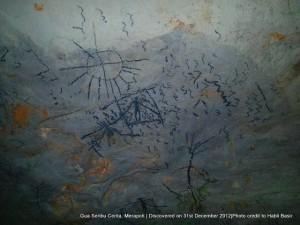
‘Agricultural’ scene at Gua Seribu Cerita. Photo: Habli Basir
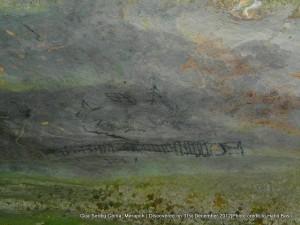
‘Train Tracks’ at Gua Seribu Cerita. Photo: Habli Basir.
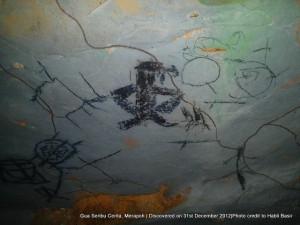
‘European figure’. Gua Seribu Cerita. Photo: Habli Basir
The ‘train tracks’, ‘European’ figure and to some extent the ‘agricultural scene’ all fit in nicely with a class of rock art called Contact Rock Art, which commonly refers to depictions of European colonialism by indigenous groups. Gua Badak in Perak also fits in with this type of rock art and the underlying idea here is that indigenous populations were drawing the novel. So while Evans noted that the Lenggong Negritos were drawing scenes from everyday life, these new people and technologies that came in where drawn in juxtaposition to the everyday and probably drawn because they were also so disruptive.
Other caves with rock art discovered in the area include Gua Gajah Gosok (Elephant Rubbing Cave), Gua Jambatan Batu (Stone Bridge Cave), Gua Lima (cave 5), Gua Susu Kambing (Goat’s Milk Cave) and Gua Jinjang Pelamin (Wedding Throne Cave7) the last two of which share the depiction of a ‘lizard’, the symbolism of which is yet to be known – group marker or hunting signal are possible explanations. It is not surprising that the rock art has been discovered as a cluster – it denotes that people have been using, and moving in and out of, these caves and they have a collective significance and function.

PART.2